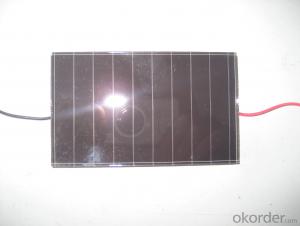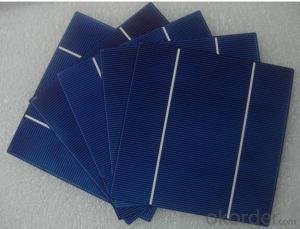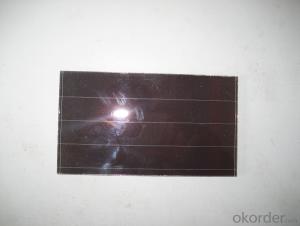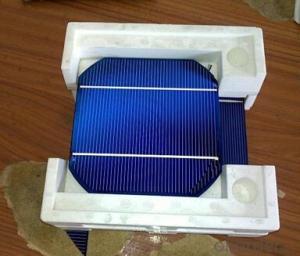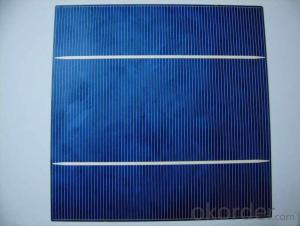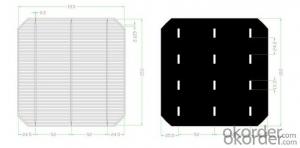Amorphous silicon dice specification 5
- Loading Port:
- China Main Port
- Payment Terms:
- TT OR LC
- Min Order Qty:
- -
- Supply Capability:
- -
OKorder Service Pledge
OKorder Financial Service
You Might Also Like
Pv modules at present, the mainstream products are still in silicon as the main raw materials, only in terms of silicon raw material consumption, production 1 mw of crystalline silicon solar cell, need 10 to 12 tons of high purity silicon, but if use the same silicon materials used to produce thin film amorphous silicon solar cell can produce more than 200 mw.
From the perspective of energy consumption, amorphous silicon solar battery only 1-1.5 years of energy recovery period, more embodies its contribution to energy saving in the manufacturing process.
Component occupies a high proportion of costs in a photovoltaic system, the component prices directly affect the system cost, and thus affect the cost of photovoltaic power generation. Calculated at the current price of components, the same money, buy amorphous silicon products, you can get more close to 30% of the power components.
2, more power
For the same power of solar cell array, amorphous silicon solar cell is about 10% more than monocrystalline silicon, polycrystalline silicon battery power. This has been the Uni - Solar System LLC, Energy Photovoltaic Corp., Japan's Kaneka Corp., the Netherlands Energy research institute, and other organizations and experts confirmed that the Photovoltaic industry.
In sunny, that is to say, under the high temperature, amorphous silicon solar cell components can show more excellent power performance.
3, better low light response
Due to the characteristics of amorphous silicon atoms are arranged disorderly, the electron transition no longer comply with the restriction of traditional \"selection rule\", as a result, its light absorption characteristics and there are big differences monocrystalline silicon material. Amorphous silicon and monocrystalline silicon material absorption curve as shown
, amorphous silicon absorption curve has obvious three sections (A, B, C). Area A corresponding electronic transition between localized states, such as the gap state near Fermi level and to the tail state transition, the absorption coefficient is small, about 1-10 cm - 1, for this is absorbing; B area absorption coefficient with the increase of the photon energy index rose, it corresponds to the electrons from the valence band edge extension state to the conduction band localized state transition, as well as the localized electrons from the valence band tail states guide for edge extension state transition, the region's energy range is usually only about half of the electron volts, but absorption coefficient across two or three orders of magnitude, usually up to 104 cm - 1; Area C corresponds to the electrons from the valence band to the conduction band internal internal transition, the absorption coefficient is bigger, often in more than 104 cm - 1. After two absorption area is crystalline silicon eigen absorption area.
Can be seen in the figure, the intersection of two curves about 1.8 ev. It is important to note that in the visible light range (1.7 to 3.0 ev), the absorption coefficient of amorphous silicon material is almost an order of magnitude larger than the single crystal silicon. That is to say, in the morning the first part of the sun is not too strong, the second half, and it's cloudy in the afternoon under the condition of low light intensity, long wave is greater, the amorphous silicon material still has a large absorption coefficient. Again considering the amorphous silicon band gap is larger, the reverse saturation current I0 is smaller. And as mentioned the amorphous silicon battery the characteristics I - V characteristic curve of the amorphous silicon solar cell both in theory and in practical use in low light intensity has good adaptation.
• I - V characteristics of amorphous silicon cells after more than a Vm with the voltage drop slowly
In order to be convenient, we draw the I - V characteristics of two kinds of batteries on the same picture. Crystalline silicon and amorphous silicon battery I - V characteristics of general shape as shown
we see from the picture, two kinds of cells in the curve changes after exceed the maximum output power point gap is bigger. Output current of crystalline silicon cells after exceed the maximum output power point will soon fall to zero, curve steep; Rather than crystalline silicon cells output current after a long distance to fall to zero, the curve is relatively flat. Two kinds of battery Vm equivalent to about 83% of its open circuit voltage and 83% respectively.
when light intensity gradually become hour, short circuit current and open circuit voltage of solar battery will be stronger. Short circuit current decreases faster, of course, open circuit voltage decrease more slowly.
do in battery solar cell array under the condition of load, when the sun battery array of effective output voltage less than the terminal voltage of battery, battery cannot be recharged. When the light intensity gradually become hour, crystal silicon battery charging does not meet the conditions, and amorphous silicon due to the larger voltage difference, do not charge until the light is very dark, effectively increase the use of sunlight time. So, amorphous silicon cells to produce more electricity than the crystalline silicon.
4, more excellent high temperature performance
High in the outdoor environment temperature, amorphous silicon solar cell performance change, depends on the temperature, spectrum, as well as other related factors. But what is certain is: amorphous silicon than monocrystalline silicon or polycrystalline silicon are less likely to be affected by temperature.
Amorphous silicon solar cells than monocrystalline silicon, polycrystalline silicon cells have relatively small temperature coefficient of amorphous silicon solar cell output power best Pm temperature coefficient is about 0.19%, and monocrystalline silicon, polycrystalline silicon cells best output power Pm temperature coefficient is about 0.5%, when the battery work at higher temperatures, the two batteries will be a drop in the Pm, but the decline is different. They can be calculated using the following formula.
- Q:Can solar silicon wafers be used in solar-powered drones?
- Yes, solar silicon wafers can be used in solar-powered drones. These wafers are commonly used in the production of solar cells, which convert sunlight into electricity. By integrating solar silicon wafers into the design of a drone, it becomes possible to harness solar energy and use it to power the drone's electrical systems, thereby extending its flight time and reducing reliance on traditional batteries.
- Q:What is the impact of impurities on the reliability of solar silicon wafers?
- Impurities in solar silicon wafers can significantly impact their reliability. These impurities can alter the electrical properties of the wafers, affecting their performance and efficiency. For example, impurities like boron or phosphorus can introduce extra charge carriers, leading to reduced carrier lifetime and increased recombination, which lowers the overall conversion efficiency of the solar cells. Additionally, impurities can also result in defects or microcracks within the wafers, compromising their mechanical integrity and long-term reliability. Therefore, minimizing impurities during the manufacturing process is crucial to ensure the reliability and performance of solar silicon wafers.
- Q:How do solar silicon wafers perform in high altitude locations?
- Solar silicon wafers perform well in high altitude locations due to the increased sunlight intensity and reduced atmospheric interference. The thinner air at higher altitudes allows for higher solar irradiance, enhancing the efficiency of solar panels. Additionally, the cooler temperatures at higher altitudes help improve the overall performance and longevity of the silicon wafers.
- Q:Can solar silicon wafers be used in solar-powered boats?
- Yes, solar silicon wafers can be used in solar-powered boats. These wafers are commonly used in solar panels to convert sunlight into electricity, which can power various systems including propulsion in solar-powered boats.
- Q:How is a front contact applied to a solar silicon wafer?
- A front contact is typically applied to a solar silicon wafer using a screen printing process. The process involves depositing a conductive paste onto the front surface of the wafer through a fine mesh screen. This paste consists of metal particles, such as silver or aluminum, mixed with a binder material. The screen is aligned with the wafer's surface, and the paste is forced through the screen using a squeegee, leaving a patterned layer of conductive material on the wafer. This front contact layer helps to collect and transport the electrical current generated by the solar cells.
- Q:Can solar silicon wafers be used in wearable fashion accessories?
- Yes, solar silicon wafers can be used in wearable fashion accessories. They can be integrated into various accessories like jewelry, clothing, or accessories such as bags and hats to harness solar energy for charging devices or powering other functionalities.
- Q:What is the price of monocrystalline silicon
- The content of silicon in the earth's crust is 25.8%, which provides an inexhaustible source for the production of monocrystalline silicon. Because silicon is one of the most abundant elements in the earth, the solar battery that destined to enter the mass market (mass market) products, reserves of advantage is to become one of the reasons the main photovoltaic silicon materials.
- Q:What is the impact of wafer resistivity on solar silicon wafer performance?
- The wafer resistivity has a significant impact on the performance of solar silicon wafers. Lower resistivity wafers allow for better electrical conductivity, resulting in improved charge carrier mobility. This leads to higher efficiency in converting sunlight into electricity. Additionally, lower resistivity helps minimize power losses and enhances the overall performance and output of solar cells.
- Q:8 inch monocrystalline silicon area?
- Generally refers to the round wafer, 8 inch refers to the diameter of 8 inches, "=2.54cm", the area of the circle you will ask for 1.
- Q:Are there any alternatives to using solar silicon wafers in solar cells?
- Yes, there are alternatives to using solar silicon wafers in solar cells. Some of the alternative materials being explored for solar cells include thin-film technologies such as cadmium telluride (CdTe), copper indium gallium selenide (CIGS), and organic photovoltaics (OPV). These alternatives offer advantages such as lower cost, flexibility, and higher efficiency in some cases. Additionally, emerging technologies like perovskite solar cells are being researched as potential alternatives to silicon wafers due to their low-cost production and high efficiency potential. However, it is worth noting that silicon wafers still dominate the solar cell market due to their well-established and reliable performance.
1. Manufacturer Overview |
|
|---|---|
| Location | |
| Year Established | |
| Annual Output Value | |
| Main Markets | |
| Company Certifications | |
2. Manufacturer Certificates |
|
|---|---|
| a) Certification Name | |
| Range | |
| Reference | |
| Validity Period | |
3. Manufacturer Capability |
|
|---|---|
| a)Trade Capacity | |
| Nearest Port | |
| Export Percentage | |
| No.of Employees in Trade Department | |
| Language Spoken: | |
| b)Factory Information | |
| Factory Size: | |
| No. of Production Lines | |
| Contract Manufacturing | |
| Product Price Range | |
Send your message to us
Amorphous silicon dice specification 5
- Loading Port:
- China Main Port
- Payment Terms:
- TT OR LC
- Min Order Qty:
- -
- Supply Capability:
- -
OKorder Service Pledge
OKorder Financial Service
Similar products
New products
Hot products
Hot Searches
Related keywords
